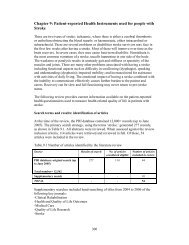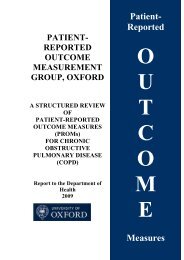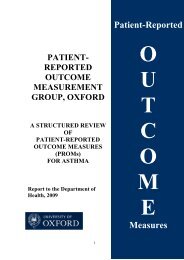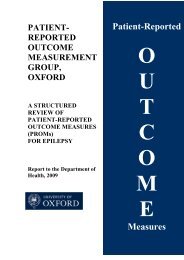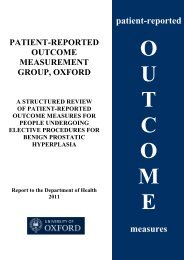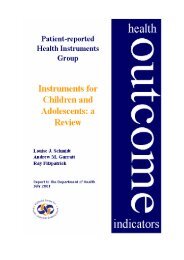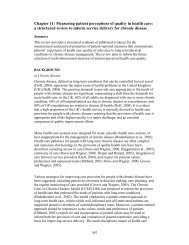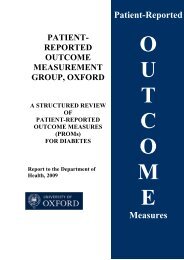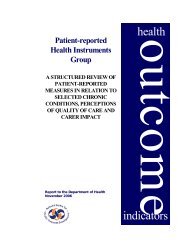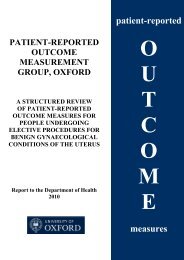2010 review - Patient-Reported Outcomes Measurement - University ...
2010 review - Patient-Reported Outcomes Measurement - University ...
2010 review - Patient-Reported Outcomes Measurement - University ...
Create successful ePaper yourself
Turn your PDF publications into a flip-book with our unique Google optimized e-Paper software.
2. PREFERENCE-BASED MEASURES<br />
Four preference-based measures were identified:<br />
a. 15D<br />
b. EQ-5D<br />
c. Health Utilities Index<br />
d. SF-6D<br />
See Appendix B, Table iii for a summary of content and scoring of these instruments.<br />
a. 15D-Measure of Health-Related Quality of Life, 15D (Sintonen, 2001)<br />
The 15D was developed as a generic multidimensional measure of HRQoL which provides<br />
both a single index score and a comprehensive health profile. Content was based on the WHO<br />
definition of health, and modified in light of contributions from health professionals, patient<br />
surveys, and factor analysis. The measure comprises 15 items encompassing physical,<br />
mental, and social well-being, with five graded responses for each item; there is no summed<br />
score. A set of preference weights elicited from the general population is used to generate a<br />
single index score between 0 and 1, where 0 is the worst (death) and 1 the best possible<br />
health. Change in score greater than 1 point per dimension, or 0.02-0.03 in the summary<br />
index, appears to reflect a clinically important difference.<br />
Two studies from 2006 were identified which evaluated the 15D with Australian patients<br />
undergoing CABG or valve surgery.<br />
Face validity of the measure is supported in a study of patients undergoing CABG or valve<br />
surgery, although the authors suggest having a single item for each dimension may limit<br />
sensitivity (Elliott et al., 2006a).<br />
Internal consistency of the 15D was reported in a study comparing patient and proxy ratings,<br />
with a median Cronbach’s alpha of 0.81 (Elliott et al., 2006b).<br />
The 15D discriminated between patient groups, with those scheduled to receive valve surgery<br />
having significantly lower pre-operative scores than those due to undergo CABG (Elliott et<br />
al., 2006a).<br />
Responsiveness of the instrument was supported (Elliott et al., 2006a), with significant<br />
improvements in score at six months post-surgery compared with baseline in several<br />
dimensions of the 15D.<br />
Response rates ranging 65%-94% for postal administration of the 15D have been reported by<br />
the developer (Sintonen, 2001), indicating moderate to good acceptability to patients.<br />
However, despite commending the brevity and ease of completion of the 15D, Elliott and<br />
colleagues report a substantial loss to follow-up (28% drop-out rate) due to patient burden in<br />
their study, where the 15D and the SF-36 were administered concurrently (Elliott et al.,<br />
2006a).<br />
b. EQ-5D (EuroQol Group, 1990)<br />
The European Quality of Life instrument (EuroQol), now generally known as the EQ-5D,<br />
was developed by researchers in five European countries as a measure with a core set of<br />
generic health status items, based on existing PROMs (EuroQol Group, 1990; Brazier et al.,<br />
8



